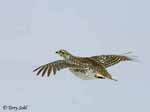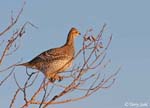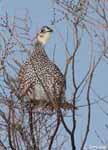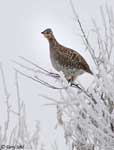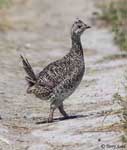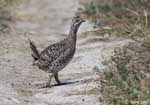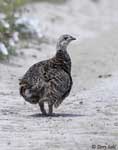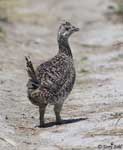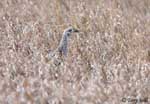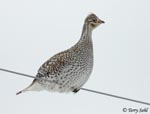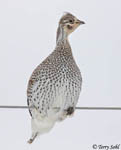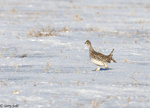| Length: 16 to 18 inches | Wingspan: 20 to 24 inches | Seasonality: All Seasons |
| ID Keys: Body shape, chevron-shaped spots on underparts, white outer feathers on tail in flight. Compare to Greater Prairie Chicken. | ||
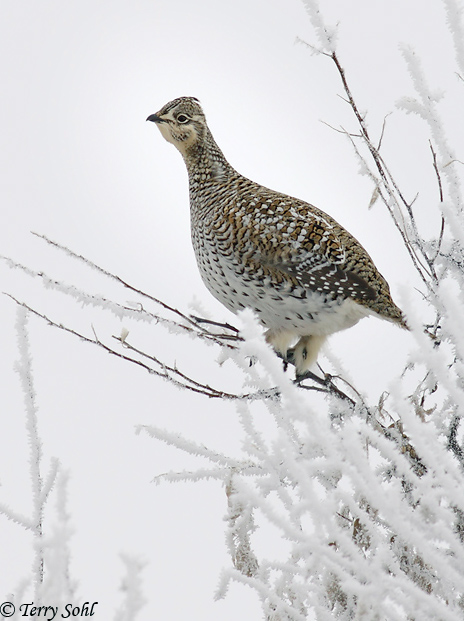 The Sharp-tailed Grouse
has a very wide geographic range, from Alaska in the north southward through the
central Great Plains of the United States, and eastward through much of Canada
and the western Great Lakes in the U.S. They have disappeared from many
parts of their historic range, including California, New Mexico, Iowa, and
Illinoise. They are generally found in more northerly locations than its cousin, the
Greater Prairie
Chicken, but their ranges do overlap in parts of the northern Great Plains.
Males gather on leks (breeding grounds) in the spring to perform their breeding
displays, with tails up wings spread, and heads held low. Males have a
"inflatable" patch on the sides of the neck that is puffed up (and brilliantly
purple in coloration) during displays on the leks.
The Sharp-tailed Grouse
has a very wide geographic range, from Alaska in the north southward through the
central Great Plains of the United States, and eastward through much of Canada
and the western Great Lakes in the U.S. They have disappeared from many
parts of their historic range, including California, New Mexico, Iowa, and
Illinoise. They are generally found in more northerly locations than its cousin, the
Greater Prairie
Chicken, but their ranges do overlap in parts of the northern Great Plains.
Males gather on leks (breeding grounds) in the spring to perform their breeding
displays, with tails up wings spread, and heads held low. Males have a
"inflatable" patch on the sides of the neck that is puffed up (and brilliantly
purple in coloration) during displays on the leks.
Habitat: Prefers grasslands and prairies with scattered groves of trees or thickets. They generally prefer more open habitats in the summer, and areas with more trees and bushes in the winter.
Diet: Feeds on a wide variety of plant matter, including seeds, leaves, berries, waste grain, buds, and flowers. They will also feed on insects in the summer, particularly when breeding and feeding young.
Behavior: Primarily forages on the ground in the summer months. Will feed more often in trees and shrubs during the winter months, and can often be found roosting in trees (see photo to the right!).
Nesting: May and June in South Dakota, with courtship behavior on leks occurring earlier. The nest of a Sharp-tailed Grouse is a simple depression on the ground, lined with feathers, grasses, leaves, and other softer materials. The female lays between 6 and 16 eggs, and she alone incubates them. The eggs hatch after about 22 days. Upon hatching, the female looks after the young, but the young move about and find their own food.
Song: Odd hoots interspersed with soft wek calls and chatters (chatters produced with feet stomping on the ground).
Migration: Generally a permanent resident, with small local movements.
Interactive eBird Map: Click here to access an interactive eBird map of Sharp-tailed Grouse sightings
Similar Species: Greater Prairie Chicken. See the species comparison chart for tips in differentiating between Sharpt-tailed Grouse and Prairie Chickens.
Conservation Status: Has disappeared throughout parts of its historic range due to habitat loss. They were once found in high numbers in Iowa, Illinois, and elsewhere in the Midwest, but disappeared when grassland habitats were converted to cropland. Similarly, habitat loss caused the loss of breeding populations in California, New Mexico, and parts of Canada. Declines in range and population are still occurring, again, primarily due to habitat loss. However, they area still found over a very wide geographic area, and are quite common in many parts of their range. The IUCN currently lists the Sharp-tailed Grouse as a species of "least concern".
Further Information: 1) Patuxent Bird Identification InfoCenter, Sharp-tailed Grouse
2) BirdWeb - Sharp-tailed Grouse
3) Audubon Guide - Sharp-tailed Grouse
Photo Information: December 19th, 2009 -- Fort Pierre National Grasslands near Pierre -- Terry Sohl
Additional Photos: Click on the image chips or text links below for additional, higher-resolution Sharp-tailed Grouse photos.
| Click ont the map below for a higher-resolution view |
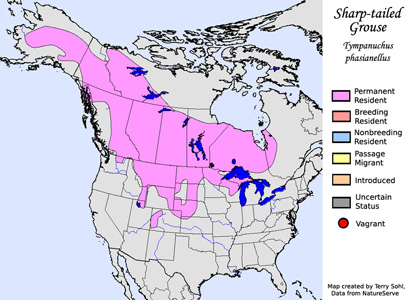 |
| South Dakota Status: Common permanent resident in much of the state, except uncommon in the northeast, and absent in the southeast. |
Additional Sharp-tailed Grouse Photos
Click for a higher-resolution version of these photos
